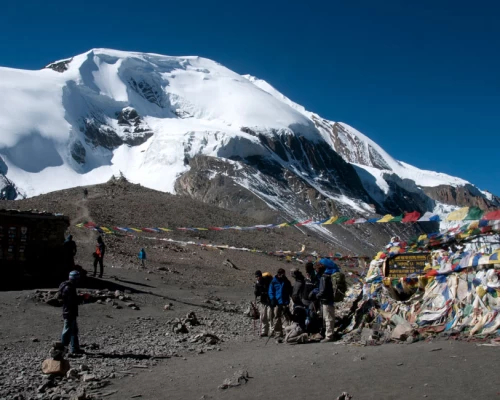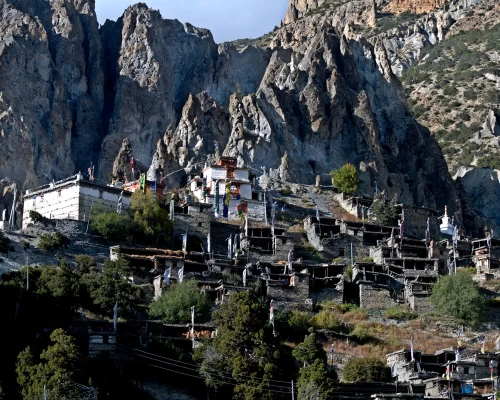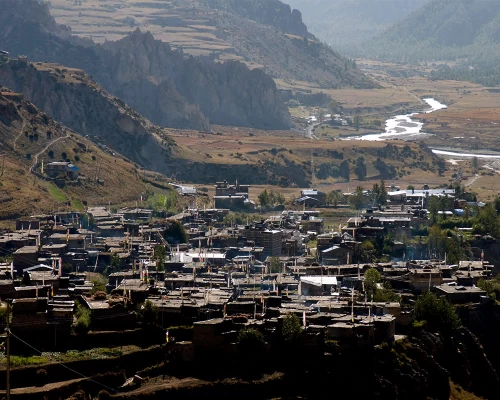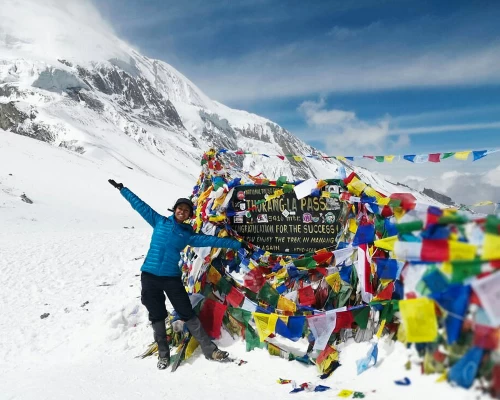Highlights
- See amazing views of the Annapurna peaks, including Machhapuchhre, Nilgiri, and Lamjung Himal in the beautiful Himalayas.
- Cross the famous Thorong La Pass at 5,416 meters, one of the highest passes in the world, with stunning mountain views.
- Visit lovely mountain towns like Manang, Braga, Kagbeni, and Jomsom, each with its own charm and culture.
- Explore the sacred Muktinath Temple and many other old temples and monasteries along the way.
- Relax in Pokhara’s lively evenings with peaceful lakeside views, cozy cafés, and fun nightlife.
- Stay in simple yet comfortable tea houses, enjoying warm food and friendly Nepali hospitality.
- Learn about the local culture and way of life by meeting and talking to the people who live in the mountains.
Annapurna Circuit Trek Overview
Annapurna Circuit Trek is the second most popular trek in the Annapurna Region, right after the Annapurna Base Camp Trek. Every year, more than 50,000 trekkers come to enjoy this adventure. The trek is famous for its incredible views of the Annapurna peaks, Machhapuchhre, Lamjung Kailash, and Nilgiri, as well as its beautiful and varied landscapes. One of the main highlights of this 15 day trek is crossing the Thorong La Pass, the highest point of the journey.
The trails are well-marked and take you past streams, rhododendron forests, and small mountain villages. The stunning mountain views are always in sight, making the trek a treat for the eyes. But the Annapurna Circuit Trek is more than just scenery. It’s a chance to walk through charming villages, stay in cozy tea houses, and meet locals and other trekkers. The warm hospitality of the people you meet along the way adds to the unforgettable experience.
At Himalayan Joy Adventure, we offer a well-organized 15 days Annapurna Circuit Trek that starts in Kathmandu. After spending two nights in Kathmandu, you will travel to Besisahar on the third day. From there, a jeep ride takes you to Jagat for your first overnight stay. The trekking starts on the fourth day, taking four days to reach Manang as you pass through lovely villages like Dharapani, Chame, and Pisang.
You will spend a day in Manang to adjust to the altitude before trekking for two days to the base of Thorong La Pass. The hardest day of the trek is crossing Thorong La Pass, but the reward is worth it as you descend into the stunning Mustang Region. On the twelfth day, you will pass through beautiful Mustang villages before staying the night in Jomsom. The next day, you will take a flight to Pokhara, where you can relax and enjoy the lively atmosphere. On the fourteenth day, you’ll return to Kathmandu. The trek ends with a farewell dinner and an airport transfer on the fifteenth day.
What Makes the Annapurna Circuit Trek Special?
The Annapurna Circuit Trek is considered a special trekking route in the Annapurna region because it combines stunning natural beauty, rich cultural experiences, and spiritual landmarks in a single journey. It offers an unforgettable adventure, and here are eight reasons why it stands out:
1) Different Types of Scenery
The Annapurna Circuit Trek takes you through many beautiful landscapes. Starting in Bhulbhule and Chamje, you will walk through green forests with waterfalls and wildlife. Along the Marsyangdi River, you’ll pass peaceful rice fields and deep valleys.
As you climb higher toward Manang, the views change to open grasslands and dry, desert-like areas. Crossing Thorong La Pass, the highest point of the trek, gives you amazing views of snow-covered mountains. On the way down to Muktinath and Kagbeni, you’ll see Tibetan-style dry lands and interesting rock formations.
The trek ends with the Kali Gandaki Gorge, the world’s deepest gorge, and the green forests of Tatopani, where you can relax in natural hot springs. Each day offers something new and exciting to see, making this trek unforgettable.
2) Stunning Mountain Views
Along the trek, you will see incredible views of some of the world’s tallest mountains. As you walk, the views keep changing, showing you the famous Annapurna peaks and others like Dhaulagiri, Manaslu, and Annapurna I. These big mountains are one of the best parts of the trek, making the whole journey memorable.
3) Local Cultures
The Annapurna Circuit gives you a chance to learn about Nepal’s different cultures. The trail goes through villages where people from different groups like Gurung, Thakali, and Tibetan communities live. In the lower areas, you will see Hindu traditions, while in higher areas, you will find Tibetan-style practices. Each village has its own way of life, language, and buildings, so it’s a great chance to connect with locals and learn about their culture.
4) Spiritual Places
The trek isn’t just about amazing views—it’s also about visiting important spiritual places. One key stop is Muktinath Temple near the Thorong La Pass. This temple is sacred to Hindus and Buddhists. Other spiritual sites along the way include Tilicho Lake, which both Hindus and Buddhists consider holy, and several ancient monasteries and caves. These spiritual stops give an added meaning to your trek.
5) Comfortable Places to Stay
Along the trek, you’ll pass through beautiful villages like Manang, Pisang, Kagbeni, and Jomsom, where you can rest in cozy tea houses. These tea houses provide a comfortable place to relax with modern amenities like western-style toilets, hot showers, soft beds, and Wi-Fi (though it may be limited in higher areas). You’ll also find tasty food, including dishes from Tibetan, Nepalese, Indian, and continental cuisines. These comfortable stops make the trek more enjoyable.
6) The Adventure of Thorong La Pass
One of the most exciting parts of the trek is crossing Thorong La Pass, one of the highest trekking passes in the world. At 5,416 meters, it’s the highest point of the trek and offers stunning views of the Annapurna and Tibetan mountains. The hike is tough but worth it. You’ll also pass the Kali Gandaki Gorge, the deepest gorge in the world, and see beautiful glacial lakes like Tilicho Lake and Kajin Sara. Afterward, you can relax at the Tatopani hot springs to unwind from the trek.
7) Seasonal Beauty
The trek is beautiful all year round, and each season has something special. In spring, rhododendrons bloom, covering the trail with colorful flowers. In autumn, the skies are clear, making the snow-capped mountains even more stunning. No matter when you go, the trek will offer you unique and amazing experiences.
8) Fun Festivals Along the Way
Trekking the Annapurna Circuit also gives you a chance to experience local festivals. In Upper Manang, you can enjoy the Yarthung Horse Racing Festival with horse races, singing, and dancing. In Lower Manang, the Metha Archery Festival has archery contests followed by dances. Every three years, the Badhe Festival in Nyeshang features a village play. Other festivals like Torkya, Dawa Dhukpa, and Nei Festival are also celebrated along the trek. These festivals let you connect with local traditions and make your journey even more special.
How physically fit do I need to be for Annapurna Circuit Trek?
The Annapurna Circuit Trek is both exciting and challenging, with high altitudes, long hours of walking, and rocky, uneven trails. Steep climbs and changing weather conditions require both physical and mental preparation.
Start preparing a few months in advance by doing activities like walking, jogging, or hiking to build stamina and leg strength. Simple exercises like yoga or stretching can help improve balance for uneven trails. If you’re carrying your own backpack, practice with some weight.
Mental strength is just as important as physical fitness. The trek can be tough at times, but staying positive, focusing on small goals, and enjoying the views along the way will keep you motivated.
You don’t need to be an expert trekker, but being in good health and reasonably fit will make the trek easier and more enjoyable. Proper preparation will help you handle the physical challenges and allow you to fully appreciate the stunning scenery and rewarding experience.
Note: See the “Useful Information” section below for more details on preparation for the Annapurna Circuit Trek.
Why Choose Himalayan Joy Adventure for Your Annapurna Circuit Trek?
Choosing the right company for your Annapurna Circuit trek is important to make sure you have a safe and enjoyable trip. A good trekking company helps you stay safe, guides you through challenges, and lets you fully enjoy the beautiful views and local culture along the way.
At Himalayan Joy Adventure, we are focused on making your trip unforgettable. We provide great service to make sure everything goes smoothly and safely. From experienced guides to personal care, we do everything we can to make sure your trek is amazing and memorable. Here’s why you should choose us:
- Experienced Guides: We have many years of experience organizing treks in the Annapurna region. Our team includes local experts who know the trails very well, so you will be in safe hands. We will guide you every step of the way to make sure your trek is smooth and enjoyable.
- Personalized Service: We know that everyone is different. That’s why we offer packages that are customized to fit your pace and needs. Whether you want a relaxed trek or something more challenging, we will make sure it’s just right for you.
- Safety First: Your safety is our number one priority. We have professional guides and experienced porters to keep you safe. We also make sure you have enough time to adjust to the high altitude, helping you avoid health problems during the trek.
- Support Local Communities: When you book with us, you support the local people of the Annapurna region. Our guides are from these areas and share their knowledge of the local culture and traditions, giving you an authentic experience.
- Comfort and Convenience: Trekking can be tough, so we try to make it as comfortable as possible. From cozy tea houses to tasty meals, we take care of everything so you can focus on enjoying the beautiful views and the journey.
Annapurna Circuit Trek cost in 2025
The Annapurna Circuit Trek costs between USD 1,450 and USD 1,990 per person. The price depends on factors like the size of your group and the services included in the trek. This cost usually covers your stay, meals, permits, and a guide, making it a great value for an unforgettable trip.
At Himalayan Joy Adventure, we offer fair prices for the 15 days Annapurna Circuit Trek based on group size. Bigger groups get lower rates, but we always provide the same high-quality service no matter the group size. Check out the detailed cost breakdown below.
| Number of pax | Starting price (Per Person) |
|---|---|
| 1-5 pax | USD $1900 |
| 6-10 pax | USD $1800 |
| 11-15 pax | USD $1700 |
| 16-20 pax | USD $1600 |
| 21-30 pax | USD $1450 |
For more information about the trek cost or to adjust your travel dates and itinerary, contact us on WhatsApp.












